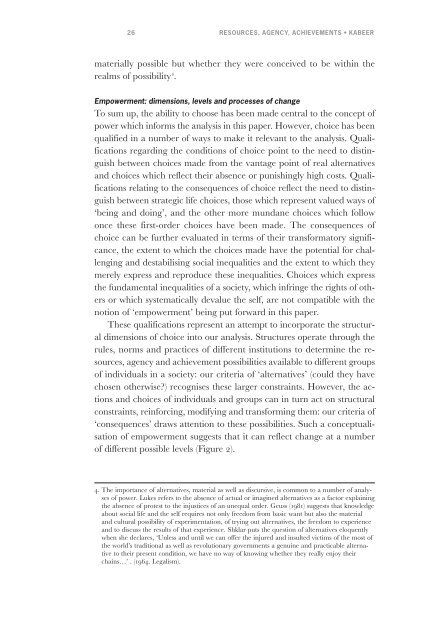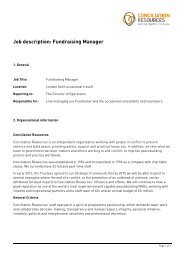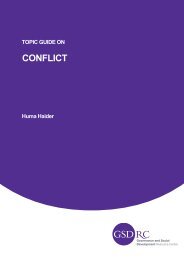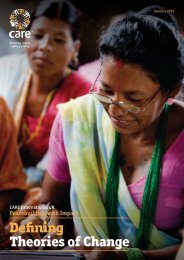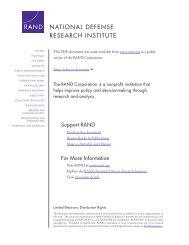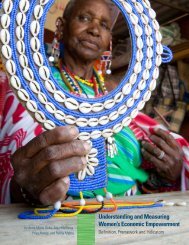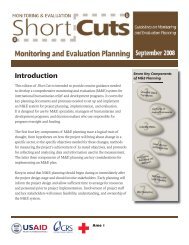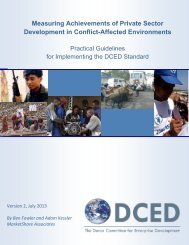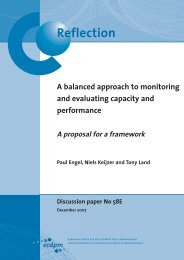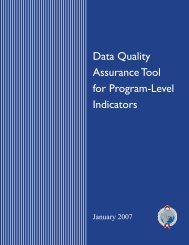Discussing Women's Empowerment - Sida
Discussing Women's Empowerment - Sida
Discussing Women's Empowerment - Sida
You also want an ePaper? Increase the reach of your titles
YUMPU automatically turns print PDFs into web optimized ePapers that Google loves.
26 RESOURCES, AGENCY, ACHIEVEMENTS • KABEER<br />
materially possible but whether they were conceived to be within the<br />
realms of possibility 4 .<br />
<strong>Empowerment</strong>: dimensions, levels and processes of change<br />
To sum up, the ability to choose has been made central to the concept of<br />
power which informs the analysis in this paper. However, choice has been<br />
qualified in a number of ways to make it relevant to the analysis. Qualifications<br />
regarding the conditions of choice point to the need to distinguish<br />
between choices made from the vantage point of real alternatives<br />
and choices which reflect their absence or punishingly high costs. Qualifications<br />
relating to the consequences of choice reflect the need to distinguish<br />
between strategic life choices, those which represent valued ways of<br />
‘being and doing’, and the other more mundane choices which follow<br />
once these first-order choices have been made. The consequences of<br />
choice can be further evaluated in terms of their transformatory significance,<br />
the extent to which the choices made have the potential for challenging<br />
and destabilising social inequalities and the extent to which they<br />
merely express and reproduce these inequalities. Choices which express<br />
the fundamental inequalities of a society, which infringe the rights of others<br />
or which systematically devalue the self, are not compatible with the<br />
notion of ‘empowerment’ being put forward in this paper.<br />
These qualifications represent an attempt to incorporate the structural<br />
dimensions of choice into our analysis. Structures operate through the<br />
rules, norms and practices of different institutions to determine the resources,<br />
agency and achievement possibilities available to different groups<br />
of individuals in a society: our criteria of ‘alternatives’ (could they have<br />
chosen otherwise?) recognises these larger constraints. However, the actions<br />
and choices of individuals and groups can in turn act on structural<br />
constraints, reinforcing, modifying and transforming them: our criteria of<br />
‘consequences’ draws attention to these possibilities. Such a conceptualisation<br />
of empowerment suggests that it can reflect change at a number<br />
of different possible levels (Figure 2).<br />
4. The importance of alternatives, material as well as discursive, is common to a number of analyses<br />
of power. Lukes refers to the absence of actual or imagined alternatives as a factor explaining<br />
the absence of protest to the injustices of an unequal order. Geuss (1981) suggests that knowledge<br />
about social life and the self requires not only freedom from basic want but also the material<br />
and cultural possibility of experimentation, of trying out alternatives, the freedom to experience<br />
and to discuss the results of that experience. Shklar puts the question of alternatives eloquently<br />
when she declares, ‘Unless and until we can offer the injured and insulted victims of the most of<br />
the world’s traditional as well as revolutionary governments a genuine and practicable alternative<br />
to their present condition, we have no way of knowing whether they really enjoy their<br />
chains…’ . (1964. Legalism).


